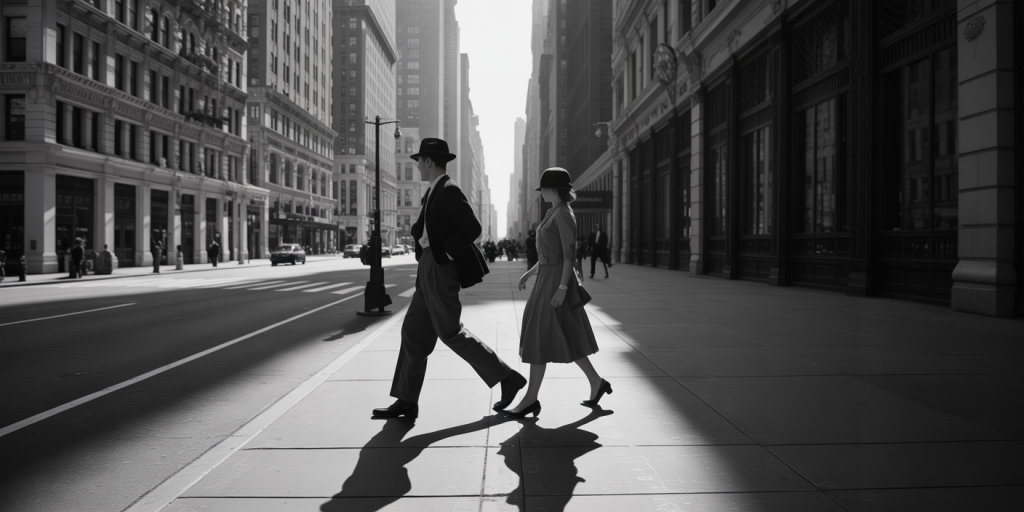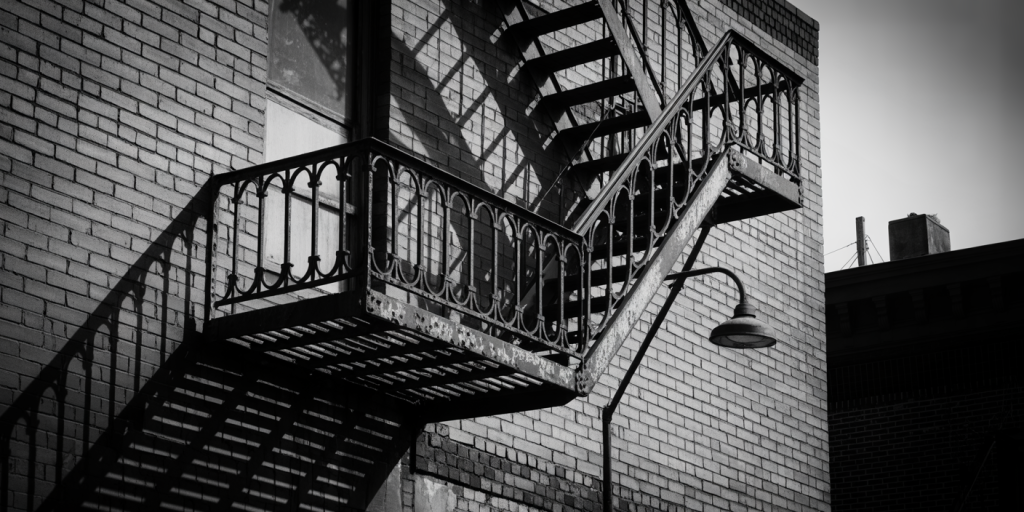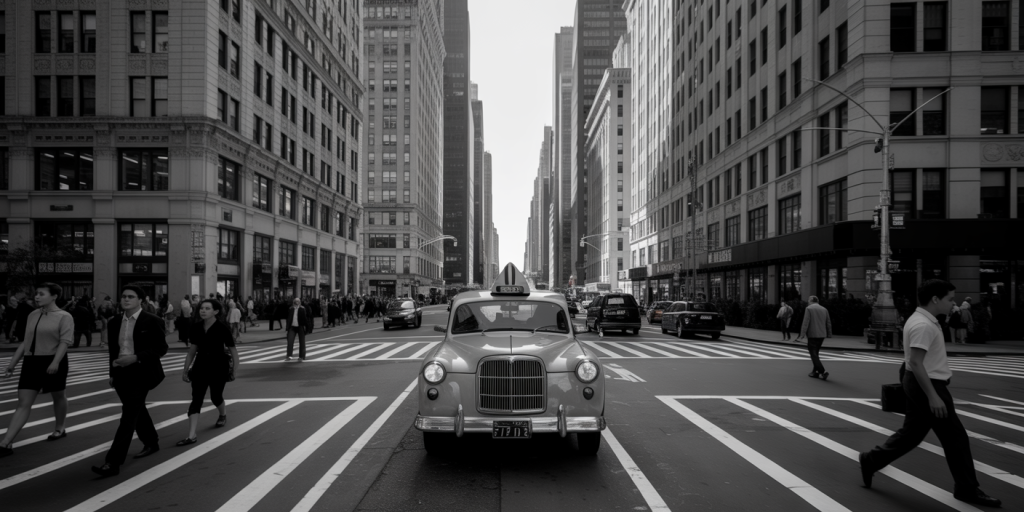Time Stops on the Sidewalks by Berenice Abbott
Beneath the patina of stone and soot, where time breathes through cracks in concrete and light halos the forgotten, lies the solemn lyric of Berenice Abbott’s gaze. Her lens does not simply observe: it listens, it waits, and then, with reverent silence, it suspends eternity. In her world, the city does not hurry. It hums. It echoes. It remembers.
The sidewalks are her parchment; the buildings, a solemn choir of form and shadow. Within each silver grain, a century exhales. Time, in her frames, pauses with dignity, caught mid-stride between memory and metamorphosis. There is no haste in her New York. There is only presence.
Table of Contents
- Streets That Whisper in Sepia
- Where Shadows Hold Their Breath
- The Brick and Bone of Civilization
- An Architecture of Echoes
- Light Etched Like Memory
- In the Stillness, Sound
- The Portrait of a Streetlamp
- The Ghosts in Glass Panes
- Composing Stillness
- Steel Bones, Human Skin
- A Geography of Poise
- Windows as Wounds and Witnesses
- The Vertical Soliloquy
- Fire Escapes Like Frozen Arteries
- The Geometry of Everyday Sacredness
- Motionless Crowds, Speaking Walls
- Solitude Rendered in Grain
- A Woman Against the Machine
- The Infinite Noon of Industrial Light
- Her Camera, a Cathedral of Stillness
Streets That Whisper in Sepia
Abbott’s streets are not corridors of movement, but sanctuaries of reflection. Each avenue breathes a burnt amber glow, as if time has aged like fine tobacco leaves pressed into memory. Sepia isn’t merely an aesthetic choice – it is the voice of nostalgia given chromatic form.
The color bends inward, folding the viewer into an intimate past that never truly left. In these hues, one can almost hear the echo of leather soles on wet pavement, the hush of fabric against stone.
Where Shadows Hold Their Breath
Abbott sculpts shadow as though it were clay. Her interplay of dark and light resists simple contrast; it becomes a meditation on presence and absence. The shadows in her work do not recede – they lean in.
They are not voids but volumes, charged with the density of everything unsaid. In the liminal space between light and dark, the city finds its soul.
The Brick and Bone of Civilization
Each brick in Abbott’s photographs is an artifact, each crack a testament to time’s careful chiseling. Her compositions favor the skeletal beauty of infrastructure: the struts and rivets, the mortar and grime.
There is something reverent in the way she aligns the human-made with the human-lived. Civilization here is not glorified but honored, shown with all its endurance and wear.
An Architecture of Echoes
Abbott’s city is haunted by itself. Every building echoes another; every facade reflects a sibling memory. She captures architecture not as structure but as story.
Windows become quotation marks. Balconies hang like footnotes. Rooftops whisper of those who once climbed them in search of skyline dreams.
Light Etched Like Memory
Her mastery of lighting is surgical yet soulful. Light in Abbott’s lens is not an illuminator but an engraver. It scores buildings, flesh, and concrete alike with an emotion that resists language.
This is not the theatrical chiaroscuro of drama. This is daylight’s whisper: honest, impartial, and enduring.

In the Stillness, Sound
A paradox emerges: the quieter the image, the louder the presence. One can almost hear the buzz of a neon sign, the whistle of wind through alleyways, the creak of wrought iron.
Abbott evokes synesthesia. Her stillness speaks, rustles, and shivers. It invites us not merely to see but to sense.
The Portrait of a Streetlamp
To Abbott, even objects are capable of self-possession. A lone streetlamp, framed against the absence of human bodies, becomes a sentinel. Not decorative, but declarative.
The lamp becomes a character. Its neck, slightly bent, holds both fatigue and vigilance. It does not merely light the street – it remembers it.
The Ghosts in Glass Panes
Windows are among Abbott’s favorite devices. In their reflections, one glimpses parallel lives: a woman adjusting her hat, a man tipping his cap, a child staring back.
Glass, in her frames, becomes a veil and a mirror. It is never empty. It always contains ghosts, seen or imagined.
Composing Stillness
Abbott was not a casual observer. Her compositions are acts of orchestration. Vertical lines conduct rhythm, diagonals introduce tension, horizontal elements ground.
She frames stillness not as lack of movement, but as abundance of presence. Every photograph becomes a held breath.
Steel Bones, Human Skin
Abbott often juxtaposed infrastructure with life: bridges looming over pedestrians, metal railings beside fragile dresses. She saw the city as a body – half machine, half mortal.
Steel may support, but it is the people who soften it. The contrast is never conflictual. It is symbiotic.
A Geography of Poise
Each image is cartography. Abbott charts not latitude or longitude, but posture, poise, and pause. People stand like punctuation marks in an urban sentence.
Her streets are not maps of movement but manuscripts of mood.
Windows as Wounds and Witnesses
A broken window is never just broken in Abbott’s world. It is a wound in the city’s skin. A shuttered storefront is a closed eyelid, dreaming of days past.
These elements testify. They speak of economic tides, social shifts, quiet tragedies, and small victories.
The Vertical Soliloquy
Skyscrapers do not merely rise; they monologue. They cast their rhetoric in bricks, concrete, and glass. Abbott positions us as audience members to their silent orations.
The vertical becomes vocal. The skyline is not background – it is speaker.
Fire Escapes Like Frozen Arteries
Her attention to fire escapes reveals her genius for metaphor. They resemble veins or arteries frozen mid-function, branching across facades with urgent stillness.
Are they escape routes or symbols of entrapment? Abbott lets the viewer decide. They are at once functional and poetic.

The Geometry of Everyday Sacredness
Nothing is mundane in Abbott’s eye. A puddle becomes a pool of reflected eternity. A curb morphs into a boundary between worlds.
Her geometry is spiritual. Right angles carry reverence. Curves whisper secrets. Each composition is a ritual.
Motionless Crowds, Speaking Walls
Even when populated, Abbott’s photographs maintain solitude. Crowds do not jostle; they linger. Walls do not echo; they speak.
In her images, the city speaks in chorus through surfaces. A poster peeling from plaster becomes a whisper. A graffiti scrawl, a scream.
Solitude Rendered in Grain
Abbott’s use of grain is deliberate. It softens and thickens, like breath on glass. It renders the lonely beautiful, the forgotten dignified.
Her grain is not visual noise. It is the hush of fog, the rasp of age. It lends her images a tactile ache.
A Woman Against the Machine
To photograph industrial New York as a woman in the early 20th century was radical. Abbott did more than document a city – she claimed it.
Her camera confronted a male-built, male-led world with clarity and nuance. She mapped the masculinity of steel with the lyricism of care.
The Infinite Noon of Industrial Light
Abbott’s photographs are often drenched in a peculiar light – neither morning nor evening, but an eternal noon. It is a clarity without cruelty.
This light levels status, scrubs glamour, reveals essence. It is the industrial made intimate.

Her Camera, a Cathedral of Stillness
Abbott’s camera is no mere tool – it is sanctuary. Through it, she built cathedrals of stillness amidst the noise. Her images become stained glass for the secular soul.
They ask for silence, demand attention, and reward with revelation. Her vision is less documentary than devotional.
FAQ
Who was Berenice Abbott?
An American photographer (1898–1991), Abbott is best known for her black-and-white images of New York City architecture in the 1930s. She was a pioneer in documentary photography and a major figure in visualizing urban change.
What was Abbott’s style?
Her work combined sharp realism with poetic composition. She used large-format cameras and embraced the aesthetic potential of architectural form, light, and shadow.
Why is Abbott’s New York significant?
Her photographs captured the tension between old and new, permanence and progress. They preserve a version of the city in transition, immortalizing a past in the very act of vanishing.
How did she influence photography?
She helped establish documentary photography as both a record and an art. Her influence shaped generations of photographers who viewed the urban landscape as a subject of profound meaning.
Was her work political?
While not overtly political, Abbott’s focus on public spaces, architecture, and the underrepresented hints at a democratic ethos. Her lens uplifted the overlooked.
Eternal Facades: Notes in the Dust
Berenice Abbott didn’t chase time. She cradled it. Her photographs are lullabies for the modern world’s most elusive treasure: the now.
In her stillness, we are reminded that nothing truly disappears. Sidewalks remember our footsteps. Buildings rehearse our stories. Shadows retain our shapes.
And so, long after the streetcars fade, the soot settles, and the bricks crumble, her images stand. Not as echoes, but as oaths.
They promise that even as the city speeds on, someone once paused long enough to see it – fully, deeply, eternally.
